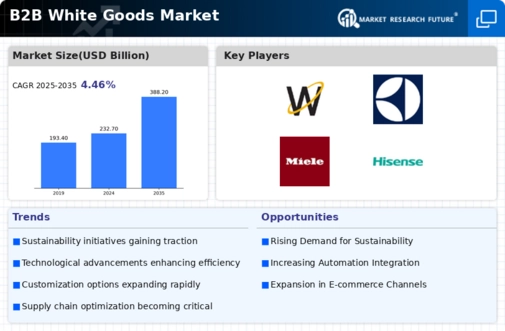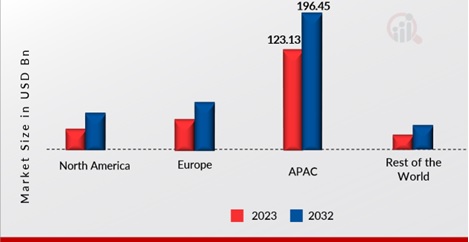-
'TABLE OF CONTENTS
-
EXECUTIVE SUMMARY 19
-
MARKET ATTRACTIVENESS ANALYSIS 20
- GLOBAL
-
B2B WHITE GOODS MARKET, BY PRODUCT 21
-
GLOBAL B2B WHITE GOODS MARKET,
-
BY END USER 22
-
GLOBAL B2B WHITE GOODS MARKET, BY REGION 23
-
MARKET INTRODUCTION 25
-
DEFINITION 25
-
SCOPE OF THE STUDY 25
-
RESEARCH
-
OBJECTIVE 25
-
MARKET STRUCTURE 26
-
RESEARCH METHODOLOGY 27
-
OVERVIEW 27
-
DATA FLOW 29
- DATA MINING PROCESS 29
-
PURCHASED
-
DATABASE: 30
-
SECONDARY SOURCES: 31
- SECONDARY RESEARCH DATA FLOW:
-
PRIMARY RESEARCH: 33
- PRIMARY RESEARCH DATA FLOW: 34
-
PRIMARY RESEARCH: NUMBER OF INTERVIEWS CONDUCTED 35
-
PRIMARY RESEARCH:
-
REGIONAL COVERAGE 35
-
APPROACHES FOR MARKET SIZE ESTIMATION: 36
-
CONSUMPTION & NET TRADE APPROACH 36
-
REVENUE ANALYSIS APPROACH 36
-
DATA FORECASTING 37
- DATA FORECASTING TECHNIQUE 37
-
DATA
-
MODELING 38
-
MICROECONOMIC FACTOR ANALYSIS: 38
- DATA MODELING:
-
TEAMS AND ANALYST CONTRIBUTION 41
-
MARKET DYNAMICS 43
-
INTRODUCTION 43
-
MARKET TRENDS AND GROWTH AFFECTING FACTORS 43
-
GROWTH PARAMETERS MAPPED - DRIVERS 44
-
TECHNOLOGICAL ADVANCEMENTS AND
-
SMART APPLIANCES 44
-
GROWING DEMAND FOR ENERGY-EFFICIENT AND ECO-FRIENDLY
-
PRODUCTS 45
-
URBANIZATION AND INCREASING DISPOSABLE INCOMES 45
-
GROWTH INHIBITORS MAPPED - RESTRAINTS 47
-
SUPPLY CHAIN AND RAW MATERIAL
-
CONSTRAINTS 47
-
INTENSE COMPETITION AND PRICE SENSITIVITY 48
-
MARKET OPPORTUNITIES MAPPED 49
-
EXPANSION INTO EMERGING MARKETS 49
- AFTER-SALES SERVICES AND MAINTENANCE: 49
-
IMPACT ANALYSIS OF COVID-19
- IMPACT ON OVERALL CONDUMER GOODS 50
- IMPACT ON GLOBAL B2B
-
WHITE GOODS MARKET 51
-
IMPACT ON THE SUPPLY CHAIN OF THE B2B WHITE GOODS
-
MARKET 51
-
IMPACT ON MARKET DEMAND OF B2B WHITE GOODS MARKET 52
-
IMPACT ON PRICING OF B2B WHITE GOODS MARKET 52
-
MARKET FACTOR ANALYSIS 53
-
VALUE CHAIN ANALYSIS 53
- RAW MATERIAL SUPPLY 53
- MANUFCATURING
-
PROCESS 54
-
DISTRIBUTION 54
- END USER 55
-
SUPPLY CHAIN
-
ANALYSIS 56
-
PARTICIPANTS (AT DIFFERENT NODES) 56
- RAW MATERIAL
-
SUPPLIER 56
-
MANUFACTURERS 57
- DISTRIBUTION 57
-
END USER 57
-
PORTER’S FIVE FORCES MODEL 59
- BARGAINING POWER
-
OF SUPPLIERS 59
-
BARGAINING POWER OF BUYERS 60
- THREAT OF NEW
-
ENTRANTS 60
-
THREAT OF SUBSTITUTES 61
- INTENSITY OF RIVALRY
-
GLOBAL B2B WHITE GOODS MARKET, BY PRODUCT 64
-
INTRODUCTION 64
-
COOKING PRODUCTS 65
-
REFRIGERATOR & FREEZERS 66
-
WASHING
-
MACHINES 67
-
LOW-END 67
- MID-RANGE 67
- HIGH-END 68
-
DRYER/TUMBLE DRYER 68
-
DISHWASHER 69
-
GLOBAL B2B WHITE GOODS
-
MARKET, BY DISTRIBUTION CHANNEL 70
-
INTRODUCTION 70
-
AUTHORIZED
-
DEALERS 71
-
DISTRIBUTERS 72
-
IMPORTERS 73
-
WHOLESALERS 73
-
RETAILERS 74
-
GLOBAL B2B WHITE GOODS, BY REGION 76
-
OVERVIEW
-
NORTH AMERICA 77
- US 80
- CANADA 81
- MEXICO
-
EUROPE 84
- GERMANY 87
- UK 88
- FRANCE 88
- ITALY 89
- SPAIN 90
- REST OF EUROPE 91
-
ASIA
-
PACIFIC 93
-
CHINA 96
- INDIA 96
- JAPAN 98
-
SOUTH KOREA 98
-
REST OF ASIA-PACIFIC 99
-
REST OF THE WORLD 101
- SOUTH AMERICA 104
- MIDDLE EAST 105
- AFRICA 105
-
COMPETITIVE LANDSCAPE 108
-
INTRODUCTION 108
-
COMPETITION DASHBOARD
- PRODUCT PORTFOLIO 110
- REGIONAL PRESENCE 110
-
STRATEGIC ALLIANCES 110
-
INDUSTRY EXPERIENCES 110
-
MARKET SHARE
-
ANALYSIS, 2023 111
-
WHO ARE THE MAJOR DISRUPTORS & INNOVATORS 111
-
WHAT STRATEGIES ARE BEING ADOPTED BY MARKET LEADERS 111
-
COMPARATIVE
-
ANALYSIS: KEY PLAYERS FINANCIAL 112
-
LIST OF KEY PLAYERS/BRANDS, BY REGION
-
KEY DEVELOPMENTS & GROWTH STRATEGIES 113
- EXPANSION 114
-
COMPANY PROFILES 116
-
WHIRLPOOL CORPORATION 116
- COMPANY
-
OVERVIEW 116
-
FINANCIAL OVERVIEW 117
- PRODUCTS OFFERED 117
- KEY DEVELOPMENTS 118
- SWOT ANALYSIS 119
- KEY STRATEGY
-
LG ELECTRONICS 120
- COMPANY OVERVIEW 120
- FINANCIAL
-
OVERVIEW 121
-
PRODUCTS OFFERED 121
- KEY DEVELOPMENTS 122
- SWOT ANALYSIS 123
- KEY STRATEGY 123
-
ELECTROLUX 124
- COMPANY OVERVIEW 124
- FINANCIAL OVERVIEW 125
- SERVICE
-
OFFERED 126
-
KEY DEVELOPMENTS 126
- SWOT ANALYSIS 127
-
KEY STRATEGY 127
-
SAMSUNG ELECTRONICS 128
- COMPANY OVERVIEW
- FINANCIAL OVERVIEW 129
- PRODUCTS OFFERED 129
-
KEY DEVELOPMENTS 130
-
SWOT ANALYSIS 130
- KEY STRATEGY 131
-
HAIER GROUP 132
- COMPANY OVERVIEW 132
- FINANCIAL OVERVIEW
- PRODUCTS OFFERED 133
- KEY DEVELOPMENTS 134
-
SWOT ANALYSIS 134
-
KEY STRATEGY 135
-
MIELE 136
- COMPANY
-
OVERVIEW 136
-
FINANCIAL OVERVIEW 137
- PRODUCTS OFFERED 137
- KEY DEVELOPMENTS 138
- KEY STRATEGY 138
-
BOSCH HOME
-
APPLIANCES 139
-
COMPANY OVERVIEW 139
- FINANCIAL OVERVIEW 140
- PRODUCTS OFFERED 140
- KEY DEVELOPMENTS 141
- KEY STRATEGY
-
PANASONIC HOLDINGS CORPORATION 142
- COMPANY OVERVIEW 142
- FINANCIAL OVERVIEW 143
- PRODUCTS OFFERED 143
- KEY
-
DEVELOPMENTS 144
-
KEY STRATEGY 144
-
IFB INDUSTRIES LIMITED 145
- COMPANY OVERVIEW 145
- FINANCIAL OVERVIEW 146
- KEY
-
DEVELOPMENTS 147
-
KEY STRATEGY 147
-
HISENSE 148
-
COMPANY OVERVIEW 148
-
FINANCIAL OVERVIEW 149
- PRODUCTS OFFERED
- KEY DEVELOPMENTS 150
- KEY STRATEGY 150
-
DATA
-
CITATIONS 152
-
MODELING FOR MARKET SHARE ASSESSMENT 39
-
BY PRODUCT, 2018-2032 (USD BILLION) 65
-
COOKTOPS/HOODS, 2018-2032 (USD BILLION) 66
-
BY REFRIGERATORS AND FREEZERS, 2018-2032 (USD BILLION) 67
-
WHITE GOODS, BY WASHING MACHINE, 2018-2032 (USD BILLION) 68
-
B2B WHITE GOODS, BY DRYERS/TUMBLE DRYERS, 2018-2032 (USD BILLION) 69
-
GLOBAL B2B WHITE GOODS, BY DISHWASHERS, 2018-2032 (USD BILLION) 69
-
GLOBAL B2B WHITE GOODS MARKET, BY DISTRIBUTION CHANNEL, 2018-2032 (USD BILLION)
-
GLOBAL B2B WHITE GOODS, BY REGION, 2018-2032 (USD BILLION) 76
-
AMERICA B2B WHITE GOODS MARKET, BY COUNTRY, 2018-2032 (USD BILLION) 79
-
NORTH AMERICA B2B WHITE GOODS MARKET, BY PRODUCT, 2018-2032 (USD BILLION) 79
-
BILLION) 91
-
(USD BILLION) 91
-
(USD BILLION) 95
-
2032 (USD BILLION) 95
-
END USER, 2018-2032 (USD BILLION) 95
-
BY PRODUCT, 2018-2032 (USD BILLION) 96
-
BY END USER, 2018-2032 (USD BILLION) 96
-
BY PRODUCT, 2018-2032 (USD BILLION) 96
-
BY END USER, 2018-2032 (USD BILLION) 97
-
BY PRODUCT, 2018-2032 (USD BILLION) 98
-
BY END USER, 2018-2032 (USD BILLION) 98
-
MARKET, BY PRODUCT, 2018-2032 (USD BILLION) 98
-
GOODS MARKET, BY END USER, 2018-2032 (USD BILLION) 99
-
PACIFIC B2B WHITE GOODS MARKET, BY PRODUCT, 2018-2032 (USD BILLION) 99
-
REST OF ASIA PACIFIC B2B WHITE GOODS MARKET, BY END USER, 2018-2032 (USD BILLION)
-
BILLION) 103
-
(USD BILLION) 104
-
2032 (USD BILLION) 104
-
PRODUCT, 2018-2032 (USD BILLION) 105
-
BY END USER, 2018-2032 (USD BILLION) 105
-
BY PRODUCT, 2018-2032 (USD BILLION) 105
-
BY END USER, 2018-2032 (USD BILLION) 106
-
MERGER & ACQUISITION 113
-
CORPORATION.: PRODUCTS OFFERED 117
-
KEY DEVELOPMENTS 122
-
ELECTROLUX: KEY DEVELOPMENTS 126
-
GROUP: PRODUCTS OFFERED 133
-
MIELE: PRODUCTS OFFERED 137
-
BOSCH HOME APPLIANCES: PRODUCTS OFFERED 140
-
KEY DEVELOPMENTS 141
-
IFB INDUSTRIES LIMITED: PRODUCTS OFFERED 146
-
KEY DEVELOPMENTS 147
-
HISENSE.: KEY DEVELOPMENT 150
-
MARKET ATTRACTIVENESS ANALYSIS: GLOBAL B2B WHITE GOODS MARKET, 2023 20
-
GLOBAL B2B WHITE GOODS MARKET ANALYSIS, BY PRODUCT, 2023 21
-
B2B WHITE GOODS MARKET ANALYSIS, BY END USER, 2023 22
-
GOODS MARKET ANALYSIS, BY REGION, 2023 23
-
STRUCTURE 26
-
RESTRAINT IMPACT ANALYSIS (2022-2032) 48
-
WHITE GOODS MARKET 53
-
ANALYSIS 64
-
ANALYSIS 70
-
(% SHARE) 71
-
GLOBAL B2B WHITE GOODS, BY REGION, 2023 (% SHARE) 76
-
MARKET: COMPARATIVE ANALYSIS 78
-
SWOT ANALYSIS 85
-
PACIFIC MARKET: SWOT ANALYSIS 94
-
COUNTRY, 2023 (% SHARE) 94
-
ANALYSIS 101
-
REST OF THE WORLD B2B WHITE GOODS, BY COUNTRY, 2023 (% SHARE) 102
-
COMPETITOR DASHBOARD: GLOBAL B2B WHITE GOODS MARKET 109
-
B2B WHITE GOODS MARKET: COMPETITIVE ANALYSIS, 2023 111
-
CORPORATION: FINANCIAL OVERVIEW SNAPSHOT 117
-
SWOT ANALYSIS 119
-
OVERVIEW SNAPSHOT 125
-
SAMSUNG ELECTRONICS: FINANCIAL SNAPSHOT 129
-
SWOT ANALYSIS 130
-
HAIER GROUP: SWOT ANALYSIS 134
-
FINANCIAL SNAPSHOT 143






